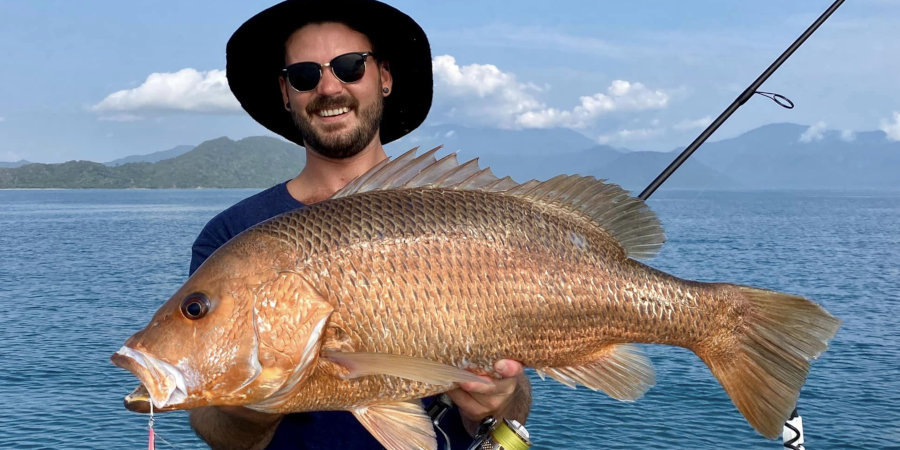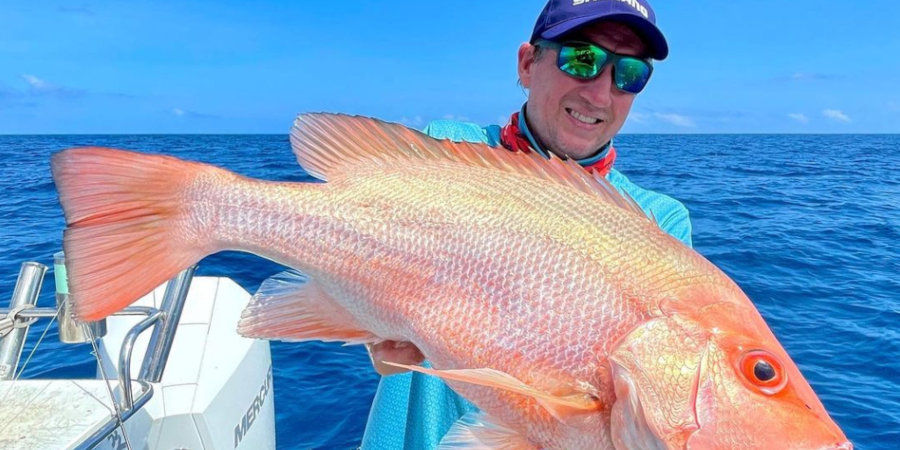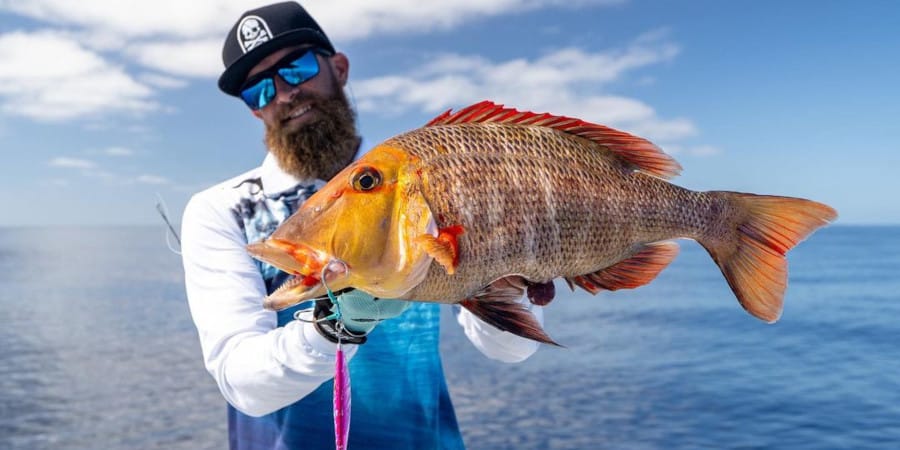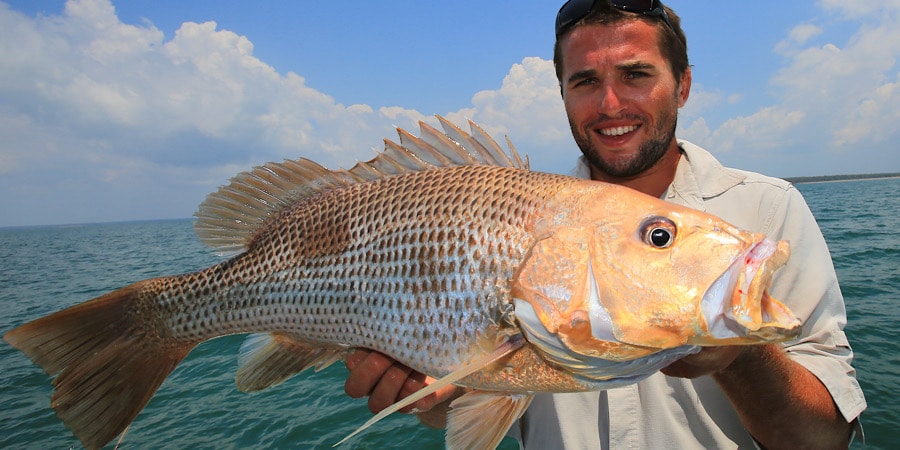EPISODE 331 is a fascinating chat with Liam about lure fishing at Lucinda, but we have other Fingermark fishing episodes here.

Liam’s Top Fingermark Bream Tips
- Fingermark are a species that is always associated with structure. In the Lucinda area that structure can vary tremendously, from the pylons of longest jetty structure in the southern hemisphere (the sugar loader jetty) to wrecks, reefs and wonky holes. Watch for aggregations of fish immediately down current of rocks and other hard structure.
- There will usually be some fingermark on each of these types of structure all year round, but these fish do tend to move inshore during the warmer months and out into deeper water during the cooler months.
- Water flow is important, but full and new moons bring big tides and strong currents that are difficult to fish. Mid-cycle moons give more manageable currents, with the last of the runout tide often being productive. Dawn and dusk are always prime times.
- Line management is important. Coloured coded lines assist in knowing what depth you’re at when jigging, but sometimes line visibility is key to seeing and reacting to bites, and multi-coloured lines aren’t the best for this.
- Matching tackle to technique is key. Some lures/techniques require relatively light tackle, especially if there is a strong current flow. However, powerful, dirty fighters like fingermark can be a challenge on lighter gear.
- Fingermark are particularly susceptible to barotrauma injuries and also to overfishing. Please fish sustainably, vent fish if necessary and/or use release weights to improve the survival of released fish.
Liam’s Preferred Fingermark Fishing Tackle
- A 30lb soft plastic spin stick with 3000 size Daiwa Certate, braid and leader is an effective all-round combo for fishing soft vibes where the drag on the line limits how heavy you can fish.
- A heavier 50lb GTK Smith Titanium spin rod with 4000 size Daiwa Catalina loaded with 50lb braid and 50lb leader gives a better opportunity of stopping fish and works well with soft plastic lures due to the heavier jig heads that can be employed.
- A Stella 5000 on a PE3 jig stick with 40lb braid and a 50lb leader is Liam’s favourite for dropping light jigs onto fingermark.
Liam’s Top Fingermark Bream Fishing Lures
- Soft vibration baits are deadly on fingermark bream. There are plenty of good options but Liam recommends sticking with lures in the 95mm range, finding the larger ones less effective on fingermark and the smaller ones too light for use in the depth of water the fish hold. Soft vibes can be cast up-current and allowed to reach bottom before being hopped back with short rod lifts. They can also be dropped from a drifting boat well before it reaches the structure where the fish are holding, allowed to reach bottom and jigged vertically as the boat drifts over the structure. The internal wire in some soft vibes isn’t up to the pressure of fighting fingermark, so removing the rear hook and upgrading the front one to a heavy-duty variety can save lost fish. The main limitation of this style of lure is the need to fish light for the lure to work, which makes it hard to land bigger fingermark.
- A 7” Berkley Gulp Jerkshad on a 1oz jig head with very solid hooks is a top fingermark lure, being a good size that smaller fish will still take but large fingermark will also take. Other 7-8” soft plastics will work too, but Liam finds that the Gulp are the most effective. Any colour will work – try switching to a different colour each time you drift over the fish. The weight of the head can be increased if need be, but Liam usually finds this a good weight for water depths from 30-100 ft. Cast the lure up current of the structure and hop it back along the bottom, winding in once it’s passed beneath the boat. Or fish it vertically, similar to the soft vibe.
- Light jigs are a great option for fingermark because they can get down to depth very quickly, don’t get chewed up and are taken freely by many species. Storm Koika jigs ranging from 20-100g are Liam’s preference. Slow jigs are often fitted with assist stinger hooks at both ends of the jig, removing the bottom hook completely is recommended as it reduces snagging. Attach your leader to the solid ring of the assist hook, leaving the lure attached with a split ring. This reduces the chances of lost fish through a ring opening up.

Conquering Port Douglas Fingermark With Isaac Fenech
Fingermark are a challenging sportfish to find and catch, but Isaac Fenech does pretty damn well with them in the inshore zone, fringing reefs islands and headlands around Port Douglas in Far North Queensland.

Five Groote Eylandt Fishing Adventures With Bomber Farrell
Bomber Farrell returns to the ALF podcast, this time to explain his top five Groote Eylandt fishing experiences!

Episode 529: Mackay Slow Pitch Jigging With Mick Hassett
My Slow Pitch Jigging technique is something I’ve been working on lately – I’m on a steep curve. Not Mick Hassett though, he’s a machine with the SPJ and in today’s interview he shares a ton of pro tips.

Mindblowing Groote Eylandt Red Emperors On The Flats
Groote Eylandt is one of Australia’s fishing wonderlands – and one of the few places where sight casting to red emperor in crystal clear water is a thing.

Cobourg Peninsula’s Incredible Golden Snapper Fishing
The Coburg Peninsula is one of those super remote, must-go destinations for anyone wanting to experience the very best f tropical coastal fishing. And Hugh Gange has it all sown up.

Conquering Port Douglas Fingermark With Isaac Fenech
Fingermark are a challenging sportfish to find and catch, but Isaac Fenech does pretty damn well with them in the inshore zone, fringing reefs islands and headlands around Port Douglas in Far North Queensland.

Five Groote Eylandt Fishing Adventures With Bomber Farrell
Bomber Farrell returns to the ALF podcast, this time to explain his top five Groote Eylandt fishing experiences!



0 Comments